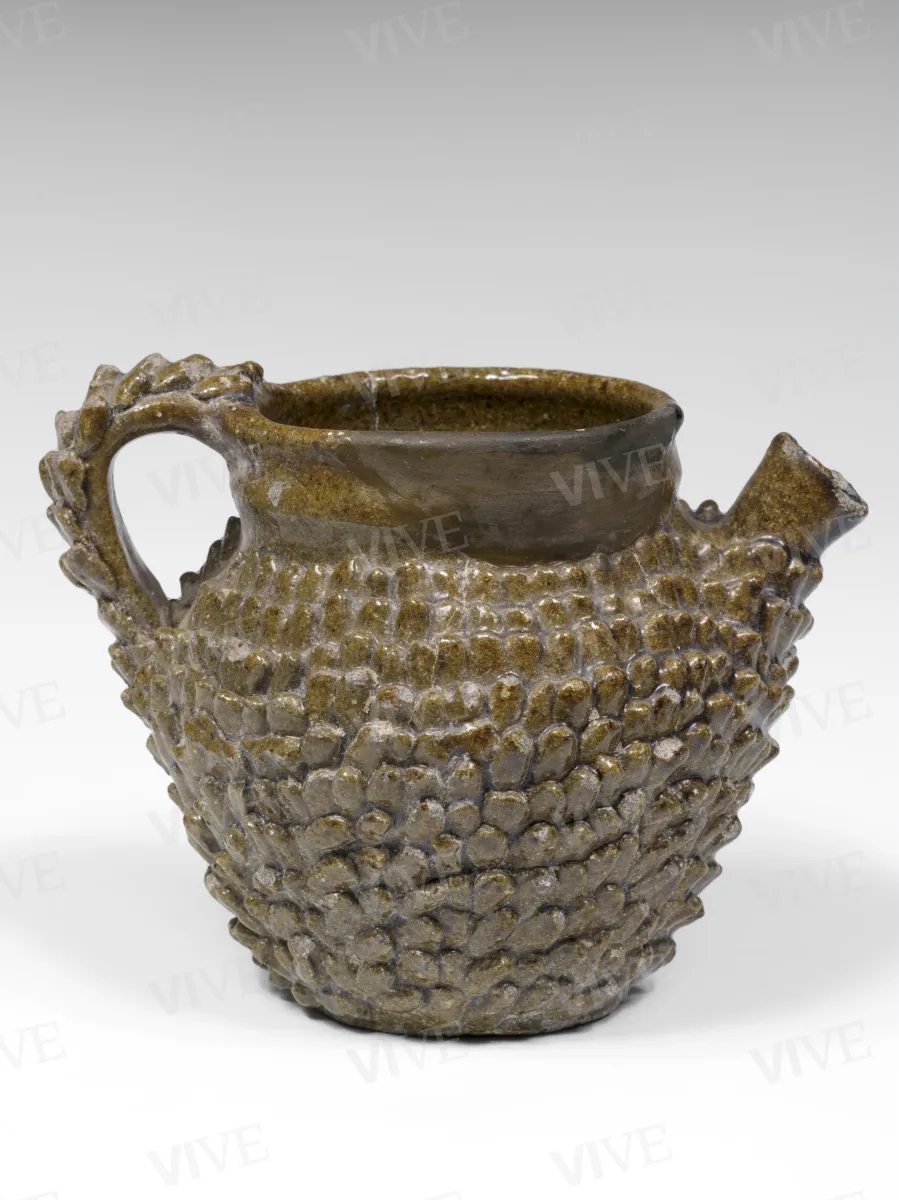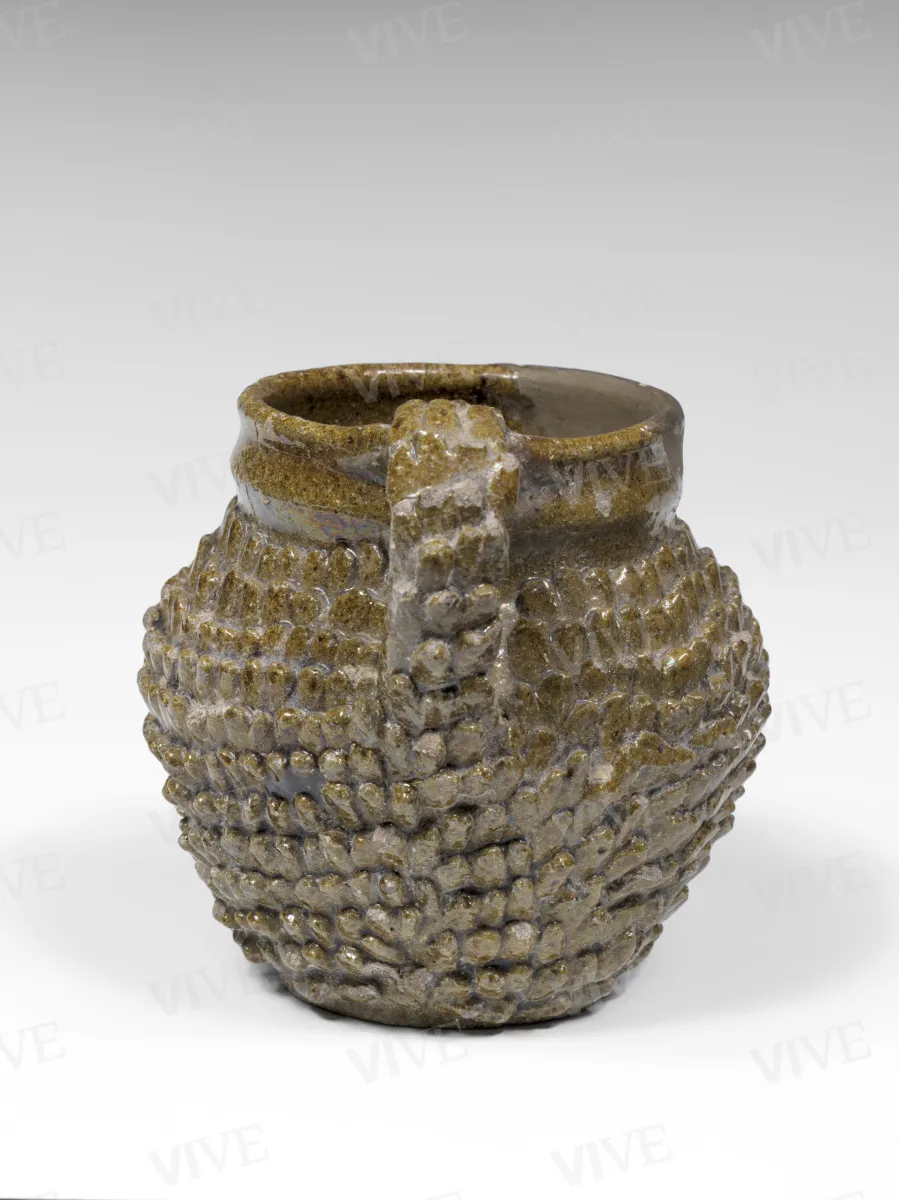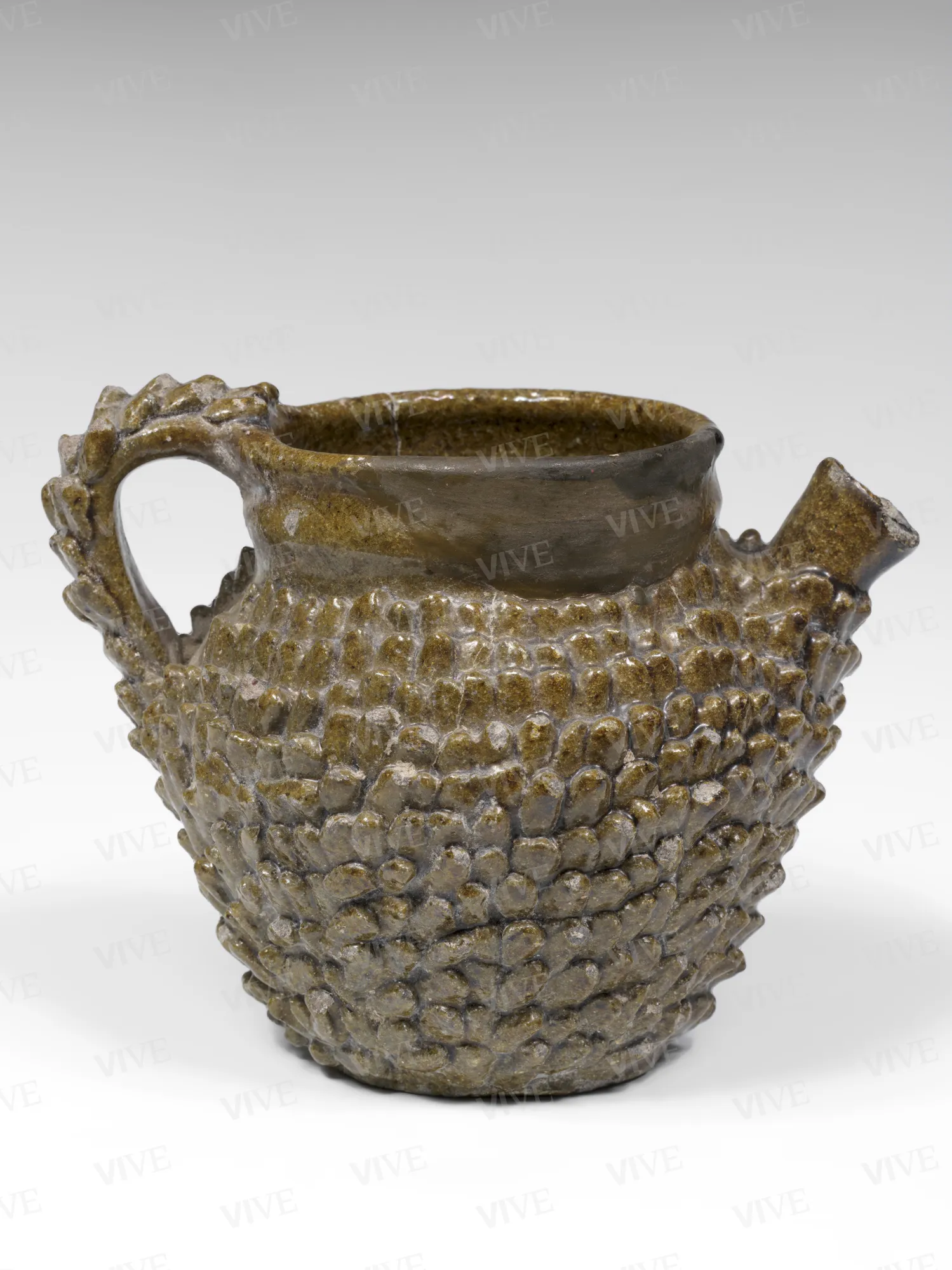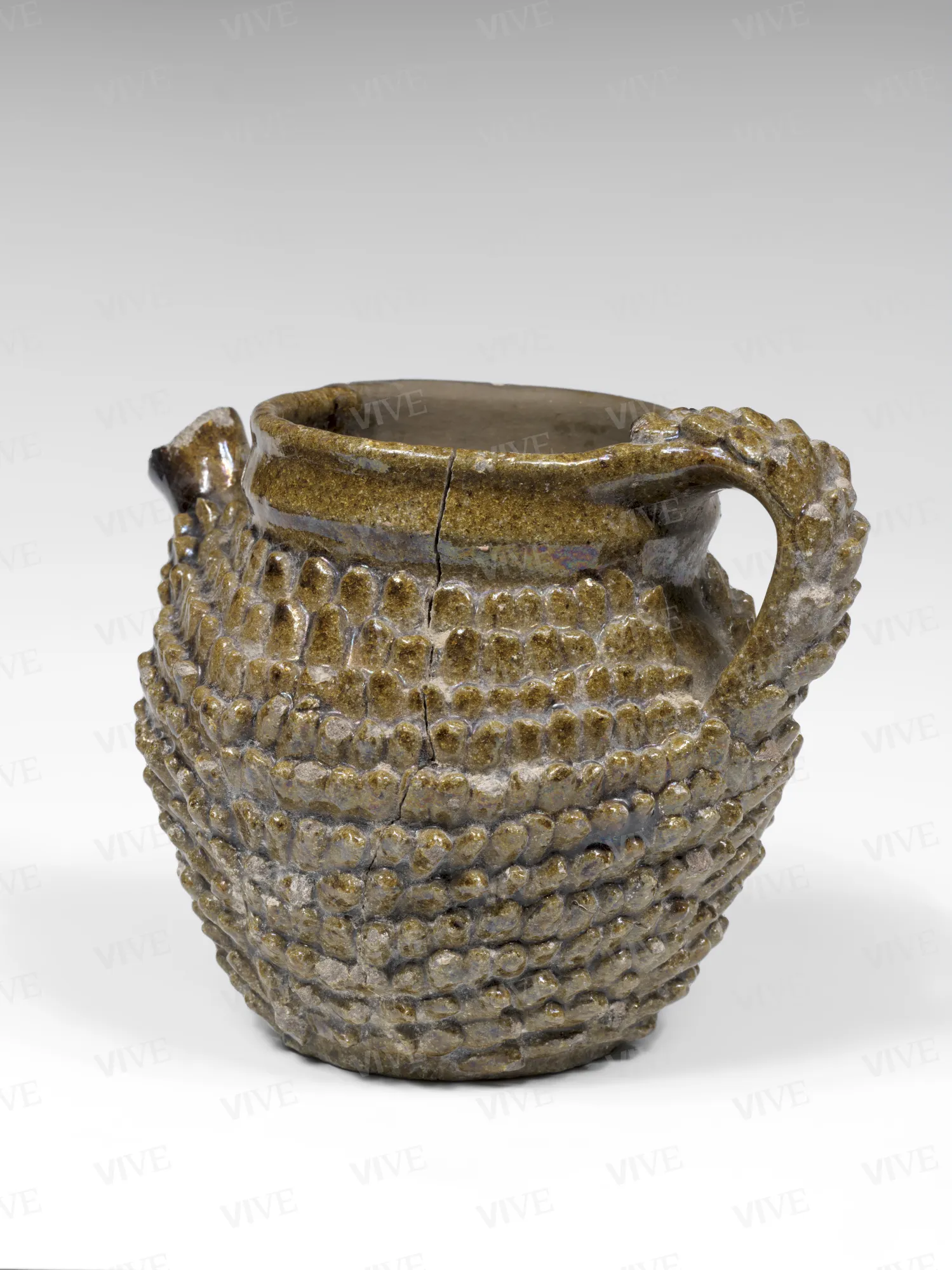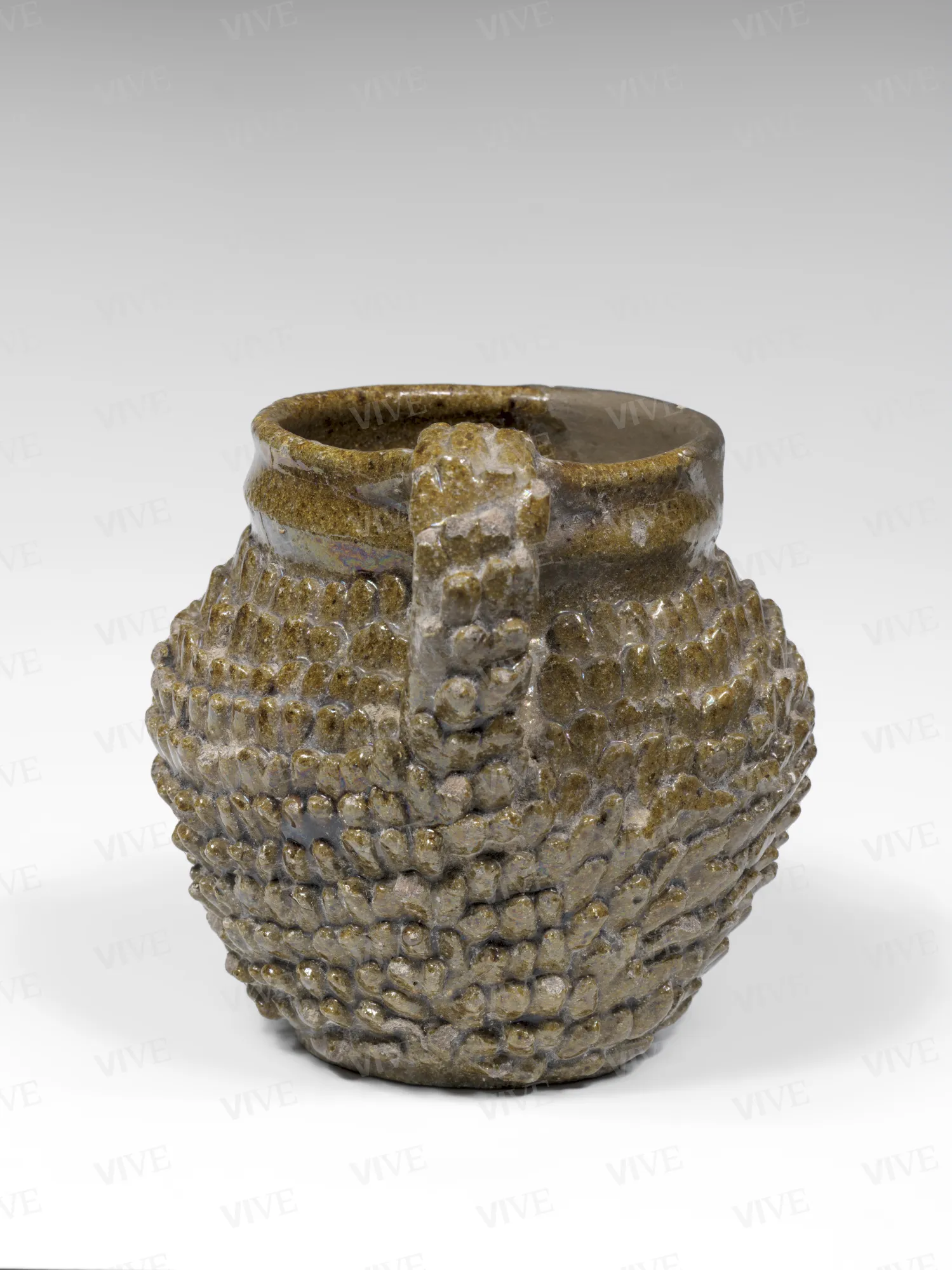Glazed pitcher with applied pine-nut decoration
Roman milieu High Middle Ages
Small globular pitcher with flat base; wide, low cylinder neck with fluting; ribbon handle set flush with the rim and short almond-shaped spout. The artifact is decorated with very thickly applied pine-nut decorations covering the entire surface except for the neck and spout; it is lined inside and out with a thick green glaze.
Small globular pitcher with flat base; wide, low cylinder neck with fluting; ribbon handle set flush with the rim and short almond-shaped spout. The artifact is decorated with very thickly applied pine-nut decorations covering the entire surface except for the neck and spout; it is lined inside and out with a thick green glaze.
Details of work
Catalog entry
Small globular pitcher with flat base; wide, low cylinder neck with fluting; ribbon handle set flush with the rim and short almond-shaped spout. This artifact is decorated with ovoid, elongated decorative elements known as ”pine-nuts” scattered over the entire surface barring the neck, and is covered both inside and out with thick green glaze. The find belongs to the Forum Ware ceramic type that was named after the first major find in 1901 of eighty whole pitchers and thousands of fragments near Lacus Iuturnae (that is, the Roman Forum) by Giacomo Boni. The type became established in Rome from the end of the eighth century. It is also referred to as “heavy glazed” because of the considerable layer of lead glaze covering it and is associated with the macro group of glazed earthen tableware. The technique used for the creation of this artifact involved the use of a lathe to mold the form, decorations applied while the clay was still wet, a vitreous covering that was spread ready to be fired, and finally firing in a kiln. The most commonly found clay mixtures are often poorly refined, porous, and full of additional material, while the glazing color varies from yellowish to green. In an early production phase the class is characterized more by closed forms, including pitchers, oil lamps, and warming trays decorated with so-called "petals" or "pine nuts," which are applied to the body of the vessel and/or the handle. Between the late-ninth and tenth centuries, it is possible to observe how morphological variety tends to diminish and the glaze becomes duller and thinner, the decorations becoming more regular, where incised underglaze decorations—characterized essentially by parallel and/or wavy lines—become common.
Specifically, the artifact is similar to materials from the Crypta Balbi, belonging to the ninth century.
Beatrice Brancazi
Entry published on 12 February 2025
State of conservation
The container is intact and in good condition except for the rim, which appears to have been partially reconstructed.
Provenance
“It probably comes from the Castel Sant'Angelo collection, without more accurate information so we cannot know the exact place from which they were recovered. Given that in addition to the eighteen pieces examined there are only a few other fragments, I presume that the material did not come directly from excavations but was found in some deposit" (Mazzucato 1993, 36–37). Mazzucato proposes two hypotheses for the provenance of the material: 1) from the 1911 Castel Sant'Angelo exhibition which was then deposited in the Castel Sant'Angelo depository at the close of the exhibition itself (like other materials from the same site about which nothing is known regarding how they arrived in Rome); 2) ceramics recovered by Borgatti during restoration work also carried out at Castel Sant'Angelo between 1920 and 1925. Hermanin (1948) affirms they come partly from the Tiber and partly from the Roman Forum at the Giuturna spring, as does Valente in his study of the ceramics preserved in the Museo di Palazzo Venezia (Valente 1939, 510–513).
References
Boni Giacomo, Notizie degli scavi, Roma 1901;
Valente Antonietta, La collezione di maioliche del Museo del Palazzo di Venezia, in«Le Arti», 1938-1939, fasci. V, pp. 510-513;
Hermanin Federico, Il Palazzo di Venezia, Roma 1948;
Mazzucato Otto, La ceramica a vetrina pesante, Roma 1972, pp. 40-41, fig. 28;
Manacorda Daniele, Paroli Lucia, Molinari Alessandra, Romei Diletta, Ricci Marco, La ceramica medioevale di Roma nella stratigrafia della Crypta Balbi, in La ceramica medievale, Atti del convegno (Siena, 8-12 ottobre 1984; Faenza 13 ottobre 1984), Borgo San Lorenzo 1986, pp. 511-544;
Romei Diletta, La ceramica a vetrina pesante altomedievale nella stratigrafia dell’esedra della Crypta Balbi, in Paroli Lidia (a cura di), La ceramica invetriata tardoantica e altomedievale in Italia, Atti del seminario (Siena, Certosa di Pontignano, 1990), Firenze 1992;
Mazzucato Otto, Tipologie e tecniche della ceramica a vetrina pesante IX-X secolo, Roma 1993, pp. 36-37;
Sannazaro Marco, La ceramica invetriata tra età romana e medioevo, in Lusuardi Siena (a cura di), Ad Mensam, Udine 1994, pp. 229-262;
Romei Diletta, Produzione e circolazione dei manufatti ceramici a Roma nell’alto medioevo in Paroli Lidia, Vendittelli Laura (a cura di), Roma dall’antichità al medioevo. II. I contesti tardoantichi e altomedievali, Milano 2004, pp. 278-311;
Campagna Lucrezia, La ceramica medievale di Roma: analisi tipologiche e quantitative per la storia economica, in «Nume», 2018, pp. 339-343.

